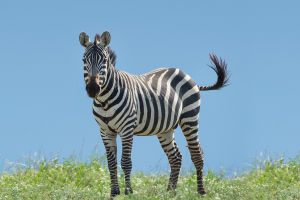Hello, Lykkers! Zebras may be famous for their stripes, but there's far more to these animals than their unique appearance. Their lives are a fascinating tapestry of social bonds, teamwork, and survival strategies.
These hoofed wonders remind us that community is not just a human concept but a vital part of thriving in the wild.
Get ready to explore the social world of zebras through some incredible stories and facts that might just make you see them in a whole new light.
Stripes That Unite: The Role of Herds
Zebras are inherently social animals, and their herds are the foundation of their social structure. A zebra herd, or "dazzle," isn't just a random group of animals—it's a closely knit community. Each herd typically includes one dominant male, several females, and their offspring. The bonds within these groups are strong, with zebras often grooming one another to reinforce trust and companionship.
Did you know? Zebras can recognize each other by their unique stripe patterns, much like humans recognize faces. These patterns help maintain unity in the herd, even in the chaos of migration or when predators are near.
Safety in Numbers: How Zebras Protect Each Other
Zebras are constantly under threat from predators like lions and hyenas, but their social behavior significantly boosts their chances of survival. The herds employ a "watch system," where some members stay vigilant while others graze or rest. When danger arises, zebras communicate using vocalizations and body language, alerting the group in seconds.
Another fascinating behavior is how they form a circle around the young, sick, or injured to protect them from predators. This selfless act highlights the strength of their community bonds.
Social Dynamics: Friendships and Alliances
Even within the herds, zebras have their favorites. Close friendships often form, especially between mothers and their foals. Stallions, on the other hand, may create alliances with other males to increase their chances of leading a herd in the future. These relationships are built over time and involve playful interactions, grooming, and even moments of conflict that strengthen their connection.
Fun Fact: Foals can stand and walk just 20 minutes after birth, which is crucial for keeping up with the herd.
Zebras and Migration: Teamwork in Motion
During the great migrations across the African plains, zebras play a critical role in leading other species like wildebeests and gazelles. Zebras' excellent memory helps them remember migration routes, water sources, and safe passageways, benefiting not only their herd but also the larger ecosystem.
Their teamwork during these treks is extraordinary. Herds stick together to ensure the safety of their youngest members and help guide others in search of food and water. This incredible coordination showcases the true power of collective effort.
Watch Beautiful Elephant And Zebra Friendship
Africa Adventures
Human Lessons from Zebra Social Bonds
Zebras demonstrate the importance of unity, cooperation, and resilience. Their herds remind us that thriving is easier with support systems in place. Whether it's protecting their young or migrating across harsh landscapes, zebras show us the value of sticking together through life's challenges.
Lykkers, isn't it amazing how much we can learn from the social lives of these incredible animals? Zebras aren't just striped wonders—they're a testament to the strength of community and teamwork. What other fascinating animal behaviors would you love to explore next? Drop your thoughts, and let's keep the conversation going!


